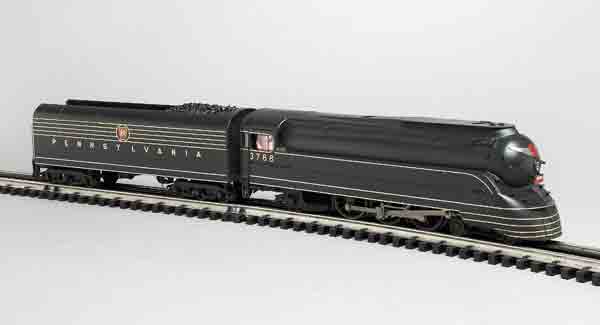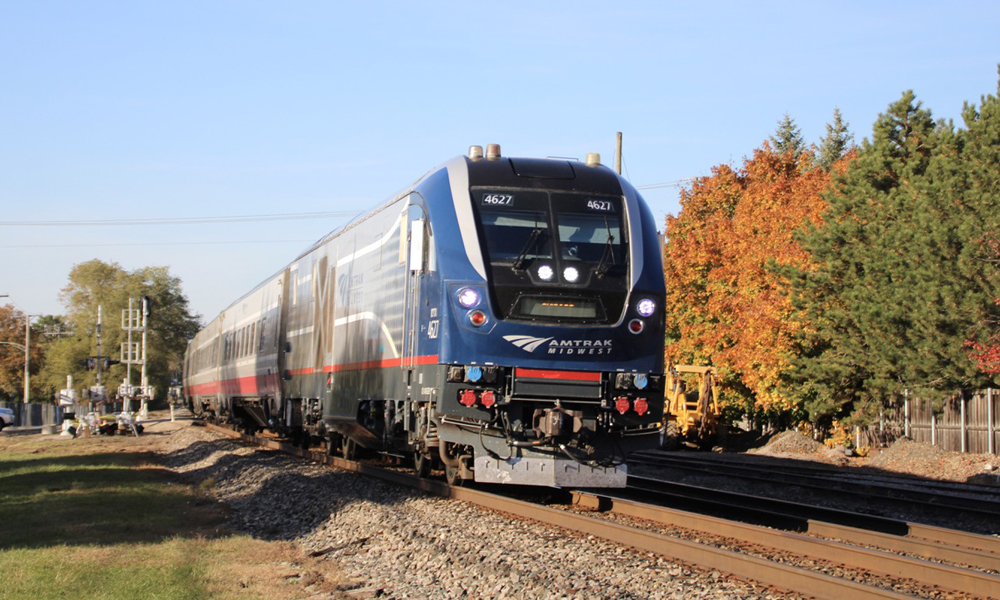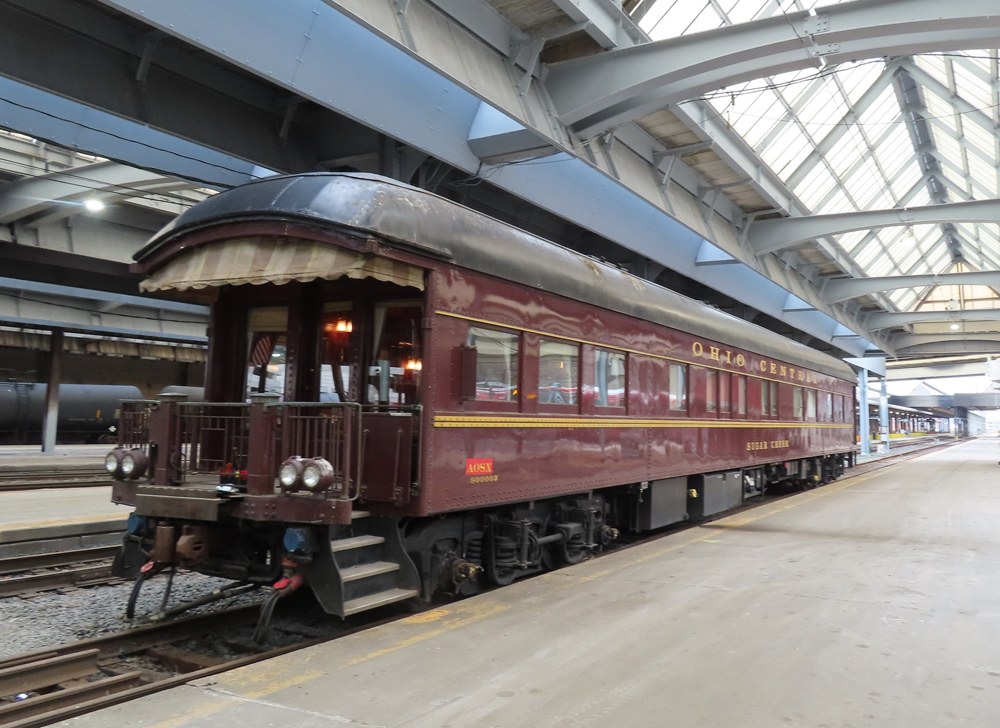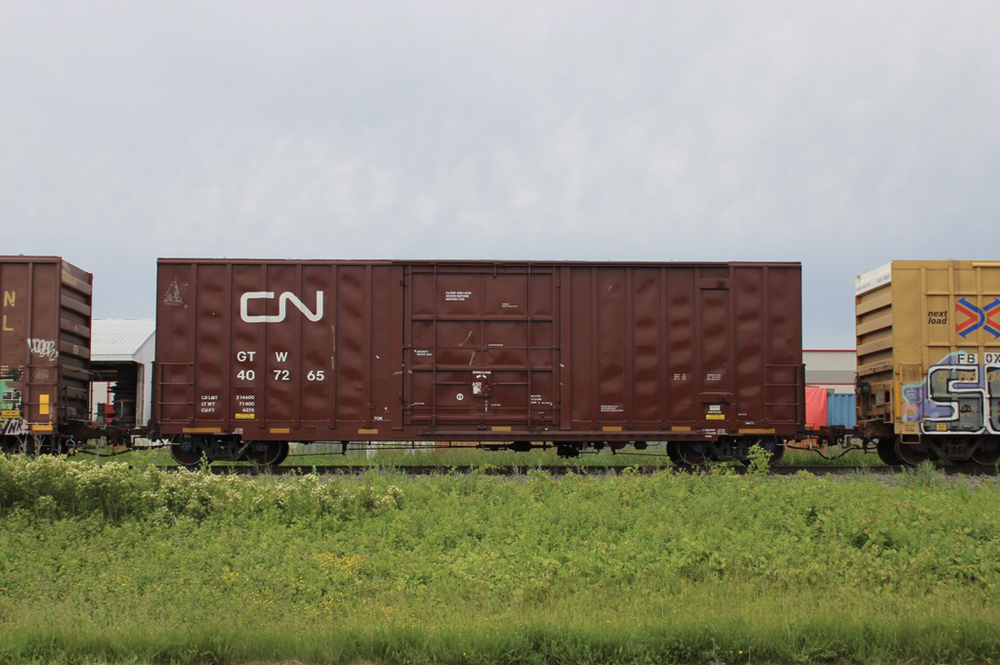The Torpedo was one of the Pennsy’s finest locomotives. With a streamlined nose, the body designed to lift the wind up and around the train, lessening wind resistance. Toss in an inset, winged PRR keystone make this locomotive look fast even while it’s sitting still.
This particular version models no. 3768, which featured streamlining created by industrial designer Raymond Loewy in 1936. Four other K4s, built in 1940 and 1941, had simplified streamlining.
The MTH Premier line version is something out of the ordinary. Its scale dimensions neatly capture the massive appearance and sleek, wind-cheating lines of the prototype. This model makes previously issued non-scale versions of the Torpedo look like toys.
The locomotive (without its tender) measures12½ inches long (50 feet in O scale). With the tender coupled to the locomotive via the wireless drawbar, the model stretches out to 96 feet in O scale. But there’s more to this model than its imposing footprint.
Opening the box
The tooling is as close to perfect as I’ve seen on a toy train. Lines that are supposed to be straight are straight, and lines that are supposed to be gently curved are gently curved. The flowing transitions between complex curves are skillfully rendered and impressive.
The pilot has one silver and four gold accent stripes, and there are three steps on each side of the nose. The smokebox has four add-on grab irons and a train nameplate for the PRR train, Spirit of St. Louis. Add-on grab irons run the length of the boiler, and you’ll find cast-in toeholds going from the gangway up to the top of the locomotive. Right behind the smokestack, an add-on bell is recessed below the roofline, with a whistle and two safety valves.
The cab’s roof hatch doesn’t open, but the side windows do. The backhead is fully decorated and has both a small bulb and firebox glow. Both cab doors open, and the cab has a drop-down footplate. You’ll find add-on grab irons bracketing both doors and window.
The 12-wheel tender measures 10¾ inches long (43 feet in O scale). The shell is wonderfully smooth, and the front of the coal bin has cast-in detail. You’ll find cast-in rivet detail on the front end and on top of the water tank. The coal load is the “chunk” type. The water-tank hatches conceal the smoke and volume controls as well as the battery re-charger port.
The rear of the tender has add-on grab irons, a ladder, and an uncoupler arm. You’ll also find a builder’s plate and a coil coupler.
The truck frames all have brake chains connecting them to the frame (four chains per truck), and the underside features a simulated water scoop. A backup light and two markers are positioned atop the rear of the tender.
Paint is generally top notch, but upon close inspection there were a few spots on the tender where it had been applied too thickly, obscuring some of the rivet detail. The striping, numbers, and lettering are solid, clear, and crisp.
On the test track
K4s operation was flawless. Our low-speed average was 2.3 scale mph, while our high-speed average was 66.7 scale mph. I’m positive you could get higher speeds on a longer straightaway than I had available!
Drawbar pull was 3 pounds.
Over the years I’ve tested a few die-cast metal steamers with bathtub-style shells. In some cases, when the locomotive was running with the sound off, the shell seemed to magnify the motor and mechanical sounds. Not so in this case. There was no more of an echo-chamber effect than found with any other die-cast metal steamer.
When this MTH steamer was running on our stationary roller set with its sound off, one visitor to the workshop said, “It sounds like a sewing machine.” That’s a fair description of the mechanical rhythm of the model’s moving parts.
The sound package is quite good. The whistle is clear and loud, but the tone didn’t appeal to me.
The coil coupler and smoke units function as designed. As is typical of MTH smoke units, you’d better watch it or it might set off your smoke alarms!
The Premier line Torpedo presents as nice a rendering of a steam-era icon as you’ll find. Performance is top notch, and you may be tempted to put this baby on the point of a hot freight train. Fans of the Pennsy and East Coast railroading will want to stand up and take notice of this model! – Bob Keller
Price: $899.95 (no. 20-3297-1)
Features: O-72 operation, can motor coil, coupler, ProtoSound 2.0, 3/2-rail convertible,
Staff comments: Terrific-looking tooling, quiet operation. O-72 operation will limit this to wide-radius operators – Bob
Made in the Republic of Korea for MTH Electric Trains















One piece of information that I would like to see in your reviews is the amperage draw of the locomotive at several scale speeds and loads. Thanks
To big and expensive for me!
MTH certainly are producing some interesting products with a novel marketing approach, and the Torpedo is a good example of catering to the scale oriented operator with it's length, wide minimum radius, and 3/2 rail convertability. This modeller, however, is probably going to have to remain in the toy train mode because the RAILKING product line is such a darn good bargain, possesing a reasonably scale appearance (through skillfull shortening -most engines seem to lose about 2-1/2" without it being too noticeable and using the same PROTOSOUND 2 electronics. The price differential between the two product lines of about $600 together with the advantage of 0-31 opeation, are going to keep me a toy train boy for some time, unless MTH can drop the price a little of that missing 2-1/2"!
If it had been designed to run on 054 curves, I probably would have ordered one of these. I don't quite understand why 072 should be required for a Pacific loco.
Possibly the large tender or the wireless draw bar has something to do with this. I buy the smaller engines in Premier but have to go with Railking for the larger ones.
Buying this beauty from MTH would set back my train purchasing budget back for two to three years! Also, I would need more space for 0-72 curves when 0-54 is a big enough problem for me.
Why does the engine slow down when the whisle blows?